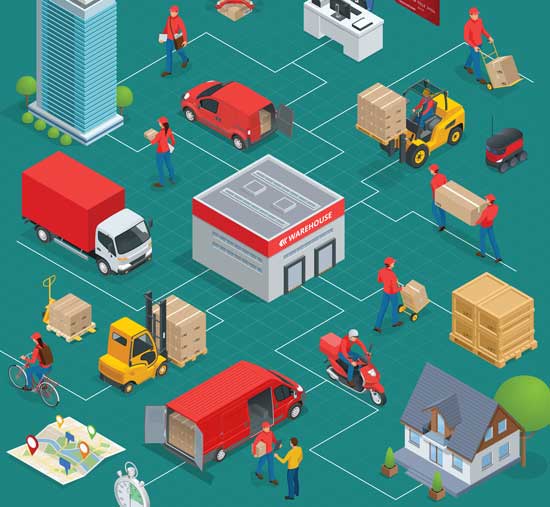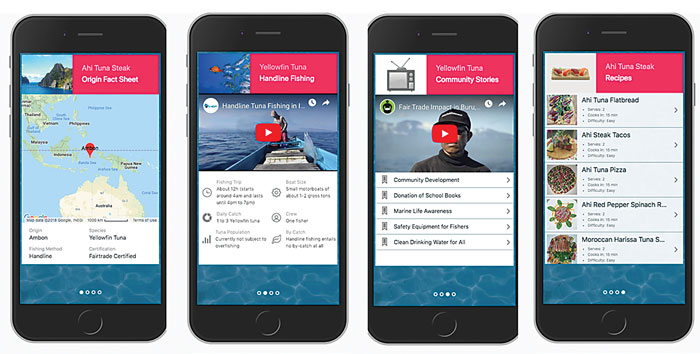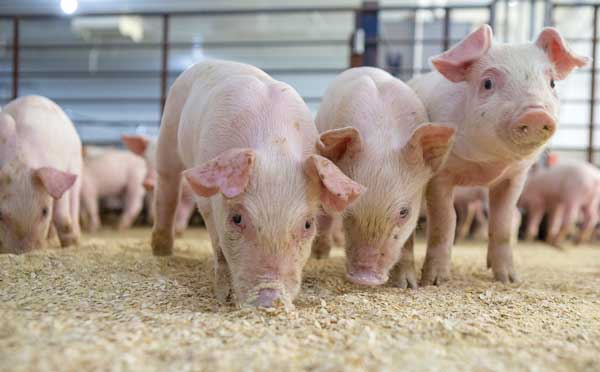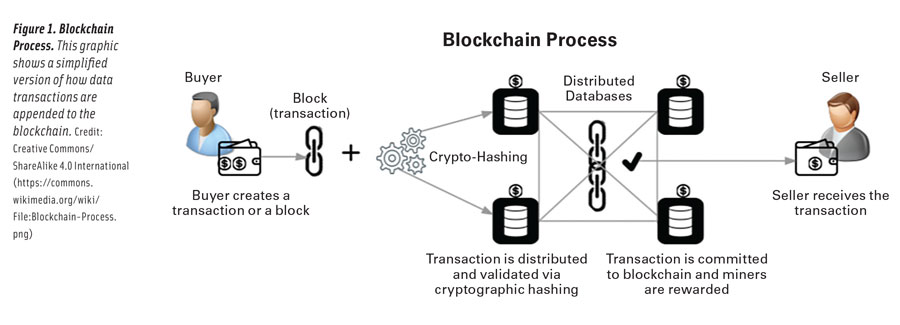
How Blockchain Is Changing the Supply Chain Conversation
Applications of blockchain promise to increase transparency and add efficiencies for the food industry, but adoption of these potentially groundbreaking new technologies will have some limitations.
Article Content
Paradigm-shifting, disruptive, radical. New technologies always seem to be associated with platitudes and promises of complete industrial transformation, but until they are tested, one never knows whether to believe the hype or not. Blockchain is no exception; it is lauded by some as the most important development in digital technology since the World Wide Web. From major retailers to produce and seafood companies, the zeitgeist of blockchain-enabled traceability has hit the food industry hard. While definitions and configurations vary, blockchain technologies can broadly be defined as distributed ledgers in which data, after being input, is immutably recorded through decentralized nodes, encryption, and timestamping. Because the decentralization configurations, resolving algorithms, and type of asset tracking can be so different, sometimes they are referred to as Decentralized Ledger Technologies (DLTs) rather than blockchain. For the purposes of this article, blockchain and DLT will be used interchangeably.
Cryptocurrencies to Supply Chains
Most people initially become familiar with blockchains and distributed ledgers in the context of cryptocurrencies, like Bitcoin or Ethereum. Cryptocurrencies are a type of digital money that use the blockchain architecture to ensure the transferring of value between two entities without the need for a trusted institutional intermediary, such as a bank or nation-state. Indeed, Bitcoin is the very first implementation of blockchain, created by the originator of the concept, Satoshi Nakamoto (Nakamoto 2008). Ethereum, the second most traded blockchain token, is envisioned as a more general decentralized ledger platform, able to be used for decentralized applications, or “Dapps,” that track assets (e.g., logistical units, game items, real estate) other than cryptocurrency (Ethereum 2019). In the past two-to-three years, the food industry has witnessed significant growth and rapid development of blockchain capabilities and implementation. The unique characteristics and capabilities of DLTs are especially advantageous to improving recall effectiveness, enabling sustainability initiatives, and increasing consumer trust.
Blockchain and Food Traceability
Damaging foodborne illness outbreaks, such as the 2018 E. coli O157:H7 outbreaks, have ratcheted up pressure on the food industry to better respond to food safety incidents and recalls. Companies are looking to blockchain as a way of uniting their supply chains to provide unprecedented levels of internal transparency and veracity. Two components make blockchain particularly attractive to food companies: timestamping and decentralization. Food is often geographic-dependent as one goes up the supply chain toward the source, with many finished food products relying on dozens of companies to make up the ingredients before the food product is ready for distribution and sale. In food, just one compromised ingredient can endanger the entire product, so there needs to be a way to account for ingredients as they feed into the larger products going downstream in the supply chain. Blockchain, with its decentralized structure, has better potential than most database solutions for uniting disparate supply chain partners; everyone from small-scale fishers and farmers to large manufacturers and retailers can have equal footing and access to traceability data. By making visibility of data bi-directional, improvements in the practices of food distribution can be made, and accountability increases.
When food industry–focused blockchain proponents talk about the possibilities of the technology, they are often talking about traceability, the ability to trace a product forward through the supply chain and to trace its history back through all critical points in the supply chain, including time, location, and transformations. In foodborne illness outbreak investigations, there are three pillars to resolving the emergency: epidemiologic investigation to ascertain which product is making people ill, laboratory data to confirm the pathogen in contaminated products, and a traceback investigation to follow the product backward through the supply chain to the point of contamination.
Advances in epidemiology and laboratory detection methods have put scrutiny on food supply chains’ abilities to trace and track products reliably in the case of food safety incidents. Food companies wish to find technological solutions to address this complex area. The ability to quickly and meaningfully share data between supply chain partners, until recently, has been difficult to do due to lower investment in digital technologies. Blockchain, having advantages like immutability and time stamping, has a natural use case in food logistics and traceability. Food supply chains have traditionally been opaque because it is a fast-moving industry where supply chain segments are not always constant, and recordkeeping is just now becoming regularly digitized. Investing in a novel technology is not surprising given these ideas.
How does blockchain work? Blockchain leverages three primary technological capabilities of the digital age: encryption, high-speed networks, and decentralized computational power. The mathematical underpinnings for blockchain technologies were developed in the 1980s with the advent of Merkle trees, cryptologically linked chains of data. However, without the high-speed networks to distribute transactions added to the ledger and widespread high-powered central processing units, it would not have been possible to implement.
 The beginnings of blockchain originated in a white paper written by Nakamoto, a person or group of persons whose identity has never been revealed. The Nakamoto white paper, “Bitcoin: A Peer-to-Peer Electronic Cash System,” envisioned a system of direct exchanging of value that avoids double-counting. Through the combination of timestamping, hash functions, and consensus algorithms, the system can achieve a “trust-less” distributed ledger of mutually assured information by all partners. Typically, data sharing and management applications or financial transactions rely on a trusted intermediary. Because of DLT’s unique architecture, participants have cryptologic proof that the results input into the system are the same as those output, known as being “trust-less.” Being used as a ledger for food traceability, the idea can be simplified into the following: a food ingredient undergoes a change in status as it moves through the supply chain (e.g., transportation). The action’s record is sent to the distributed networks of nodes where a resolving algorithm verifies that the desired record change is true. Then the blockchain commits the change and is permanently part of the record.
The beginnings of blockchain originated in a white paper written by Nakamoto, a person or group of persons whose identity has never been revealed. The Nakamoto white paper, “Bitcoin: A Peer-to-Peer Electronic Cash System,” envisioned a system of direct exchanging of value that avoids double-counting. Through the combination of timestamping, hash functions, and consensus algorithms, the system can achieve a “trust-less” distributed ledger of mutually assured information by all partners. Typically, data sharing and management applications or financial transactions rely on a trusted intermediary. Because of DLT’s unique architecture, participants have cryptologic proof that the results input into the system are the same as those output, known as being “trust-less.” Being used as a ledger for food traceability, the idea can be simplified into the following: a food ingredient undergoes a change in status as it moves through the supply chain (e.g., transportation). The action’s record is sent to the distributed networks of nodes where a resolving algorithm verifies that the desired record change is true. Then the blockchain commits the change and is permanently part of the record.
Applying Blockchain to Food Supply Chains
What does this mean for food supply chains and traceability? The general structure of blockchain architecture has key similarities to food supply chains: time-dependent record keeping; immutable handoff of material; and an ordered, but fractured, exchange structure. Because record keeping is distributed, it has piqued the interest of downstream supply chain partners to ease data collection and hosting upstream (i.e., harvesters and producers).
There are also philosophical components to the enactment and implementation of blockchain schemes in food supply chains. The growing movement of using blockchains as unified entities of proven, authentic information is immensely attractive to a high throughput while simultaneously fraud-vulnerable industry such as food. By having a ubiquitous depository of data that isn’t reliant on a single entity, data governance can be shared across the supply chain and can contribute to the idea of food as a digital product. In developing blockchain solutions for food traceability, the goal is to create a “digital twin” where the physical product is mirrored onto the blockchain and can provide comprehensive accounting of it in digital systems. This often has been the key sticking point of previous information systems to provide traceability information and why paper has been such a mainstay.
Food Fraud and Data Integrity
One of the key aspects of blockchain that hasn’t been fully explored yet is its often-touted headline that it prevents fraud. In the food supply chain, fraud and misleading product is a hard issue to solve. When you have product that is harvested, processed, and sold in tight time intervals, it can be difficult to ascertain the authenticity of the given product without inside knowledge or expertise, which is much of what the industry has relied on in the industrial agriculture era. However, the only information that is assured on the blockchain is that the previous information is linked to the next transaction. This works great in financial technology and cryptocurrency applications because the entire life cycle of the product always occurs digitally. Food, on the other hand, is a physical product that cannot be traded and commodified purely digitally; on some level, the product must be moved and accounted for by physical means to assure its authenticity. This is one of the key problems being explored in food traceability technologies right now: how do you validate data going into a system?
A favorite phrase among blockchain skeptics is “garbage in, garbage out.” If a fraudulent (or merely misinformed) player inputs incorrect information, that bad data is spread downstream. How do we set up a system that can overcome the limitations of human error or malice? The answer revolves around how much visibility there should be in food supply chains. Having more open or transparent data systems where traceability information flows both ways, that is, upstream toward producers and downstream toward retailers, means that all players in the food production ecosystem can increase accountability. Producers may be able to see that their product is misrepresented downstream or retailers may be able to note discrepancies in reporting by suppliers. The consequence of this bidirectional shift in data is that it has the power to disrupt the entire economic sector.
Because of unique attributes to the food industry, much profitability is reliant on sensitive business knowledge on suppliers and predictive analytics. By opening up food supply chains’ data, there is a strong possibility that the data collected may dramatically change crop production and ingredient allocation to reduce food waste. Even with the most advanced digital traceability systems in place currently, the information is partitioned and unable to be utilized by researchers or data analysts to understand the food system. If visibility of data goes beyond immediate trading partners, everything from pricing information to quality metrics will be more directly measured and accessible.
Where Do Other Technologies Fit?
How do other emerging technologies combine with blockchain? Since blockchain is a networking application, other technologies that feed into a data system are natural complements to this emerging area. Internet of Things (IoT) devices are being heavily explored in food supply chains because they enable robust, continuous data collection on products as they move from source to sale. Sensors gauging metrics like temperature, humidity, and motion can give live feedback to the supply chain operators to ensure that product is kept in safe conditions. Being able to measure these attributes is not a new concept to food supply chains, but being able to network them collectively and in real time is. IoT devices are also seen as key components to ensuring that there is physical-digital linkage between a blockchain and the product. Devices like cryptotags developed by companies such as Riddle and Code provide that linkage. Basically, a cryptotag is an embedded private key that ties the product to the blockchain directly, typifying the “digital twin” concept.
Artificial intelligence (AI) and big data analytics are other emerging technologies that associate with blockchain. As data becomes more prevalent through the comprehensive collection of digital data, AI and other analytics will be able to forecast market trends and further reduce waste and loss of food.
Drawbacks and Limitations
But what are the caveats of blockchain? Is it really a silver bullet solution? There are three major issues with blockchain and DLTs: public versus private configurations, latency, and size limitations. Latency is the foremost issue in blockchain implementations, especially public ones. This refers to the time it takes to append transactions to the blockchain. For Ethereum, its range is from 7–15 transactions per second. For reference, VISA can handle 30,000 transactions per second. The nonprofit group GS1, developer of a widely used system of supply chain standards, estimates that 6 billion objects are scanned per day.
Any type of global system needs to have a faster transaction time than what current blockchain solutions have. Proposed solutions to current implementations are different resolving algorithms, having private or consortium networks, or bulk committing transactions to the blockchain. Each of these have some issues that go against the core tenets of blockchain promises. When you have consortium or private networks, the transparency and shared accountability is reduced. Bulk transactions (every hour, day, etc.) may make less sense in food because you may have product that moves through its supply chain in 48 hours. It is also expensive to upload data to the blockchain. It is not feasible to put pictures, PDFs, and other documents on the blockchain, which may be essential for food safety documentation purposes.
Examples and Implementations
Implementations of blockchain have rapidly evolved over the past year. When the Institute of Food Technologists first published its blockchain fact sheet in 2018, a handful of companies were doing pilots and early implementations in supply chains (GFTC 2018). Now we see an explosion of both startups and established food and technology companies taking on blockchain as the logical next step in the progression of database technologies. In general, piloting and implementation have occurred primarily in commodities like seafood, meat and poultry, or coffee, rather than consumer packaged goods.
Seafood is one of the most difficult food commodities to track and trace due to it being caught, harvested, raised, and distributed all over the world. Additionally, tracing seafood back to its source can help ascertain whether it was caught legally and authenticate product in the supply chain while also addressing food safety contingencies. Increasingly, seafood companies are turning to blockchain to enhance traceability.
 This spring, Bumble Bee Foods announced at the conference and musical festival South by Southwest that it is partnering with SAP’s cloud platform blockchain service to trace yellowfin tuna from the Indonesian ocean to consumers’ tables. Because consumers are demanding more accountability from seafood suppliers (especially whether the product has been sustainably sourced and legally caught), Bumble Bee is looking to provide consumers with a QR code so they may easily look up the journey of the tuna they are consuming (SAP 2019). Pacifical, the largest tuna producer in the world, has used the Ethereum blockchain to trace all of its tuna from catch to retail (Undercurrent News 2019).
This spring, Bumble Bee Foods announced at the conference and musical festival South by Southwest that it is partnering with SAP’s cloud platform blockchain service to trace yellowfin tuna from the Indonesian ocean to consumers’ tables. Because consumers are demanding more accountability from seafood suppliers (especially whether the product has been sustainably sourced and legally caught), Bumble Bee is looking to provide consumers with a QR code so they may easily look up the journey of the tuna they are consuming (SAP 2019). Pacifical, the largest tuna producer in the world, has used the Ethereum blockchain to trace all of its tuna from catch to retail (Undercurrent News 2019).
Even nonprofits have gotten in on the blockchain train, with WWF-Australia using a platform called OpenSC to track seafood from catch to consumer. Combining radio frequency tags, machine learning algorithms, geolocation, and QR codes, this product is a consumer-facing app to show a company’s sustainability practices and transparency (WWF-Australia 2019).
 Seafood is not the only commodity where blockchain is being explored. The National Pork Board and ripe.io have partnered together to trace pork as a way of validating sustainability benchmarks (Ripe Technology 2019). Ripe.io emphasizes transparency in its supply chains to address “sustainability, quality, traceability, waste, and fraud.”
Seafood is not the only commodity where blockchain is being explored. The National Pork Board and ripe.io have partnered together to trace pork as a way of validating sustainability benchmarks (Ripe Technology 2019). Ripe.io emphasizes transparency in its supply chains to address “sustainability, quality, traceability, waste, and fraud.”
TE-FOOD is a curious take on using cryptoeconomics to facilitate the adoption of food traceability digital technology through incentivizing upstream data collection. Most recently, the technology supplier introduced a blockchain solution that traces beer ingredients from farm to can, called the “Bock Chain” (Wyers 2019). Finally, IBM FoodTrust is continuing to partner with new companies and organizations, such as Producers Market, creator of a platform for exchanging agricultural assets, as well as Dole and Walmart (Producers Market 2019).
Predicting the Future of Blockchain
It is still the early days of blockchain and DLTs, but it is apparent that they will play a major role in the transparency in supply chain movement. Before blockchain, business-to-business information exchange was never envisioned to go beyond one step up or one step down, but now DLTs are enabling the capability to see traceability information from end to end. From reduced food waste and loss to illegal practices to food safety, blockchain and distributed ledgers may totally transform the food industry. Conversely, mathematical or computational realities may prevent the vision of more transparent supply chains from truly being achieved. What is assured is that distributed ways of sharing and storing data and end-to-end traceability will continue to proliferate.
About the Author
Thomas Burke is a food traceability and safety scientist with the Institute of Food Technologists’ Global Food Traceability Center ([email protected]).
Food Technology Articles

How to Achieve EPR-Forward Packaging
In this two-part series, the author explores the history of Extended Producer Responsibility (EPR), what is needed to help EPR succeed, and how brands can best prepare for EPR.

Future Food-Tech 2024 Tackles Transformation, Underscores Collaboration
Mission-driven Future Food-Tech exhibitors and conference presenters showcased innovative, transformative ingredients and technologies and emphasized the importance of collaboration in addressing food system challenges.

Whipping Up a Bright New Idea
A profile of whipped cream category innovator Whipnotic.

Keeping the ESG Promise
An infographic describing food and beverage companies’ outlooks regarding ESG initiatives.

Natural Product Expo West Attention-Getters: Highlights From the Event
Food Technology Contributing Editor Linda Milo Ohr reports on trends she tracked at Natural Products Expo West 2024.
IFT Podcasts

Episode 33: Global Food System Challenge Growth Grant Winners
Join us to celebrate the Global Food System Challenge Growth Grant Winners. Representatives from Food Systems for the Future (FSF Institute), iDE Global, and the African Center for Technology Studies discuss their work and the role that the generous funding from Seeding The Future Foundation plays in helping to make healthier diets more accessible and empowers consumers to make choices benefitting both personal and planetary health.

Episode 32: Global Food System Challenge Grand Prize Winners
Join us to celebrate the Global Food System Challenge Grand Prize Winners. Representatives from the International Rice Research Institute, Solar Freeze, and WorldFish discuss their work and the role that the generous funding from Seeding The Future Foundation plays in helping to make healthier diets more accessible and empowers consumers to make choices benefitting both personal and planetary health.
EP 10: Current State of African Swine Fever
African Swine Fever (ASF) continues to be hot topic to those working in food. ASF has been spreading across the globe, killing millions of pigs and is a viable threat to the US pork industry as it has recently reached the Dominican Republic.


